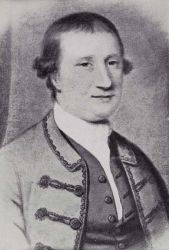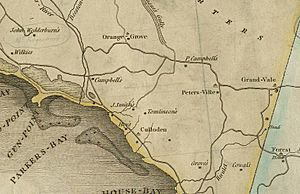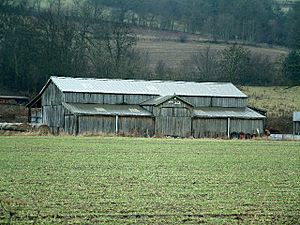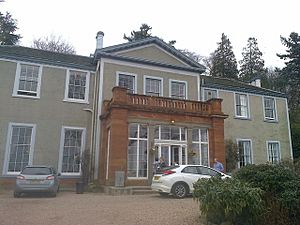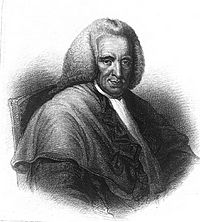John Wedderburn of Ballindean facts for kids
Quick facts for kids
Sir John Wedderburn of Ballindean
|
|
|---|---|
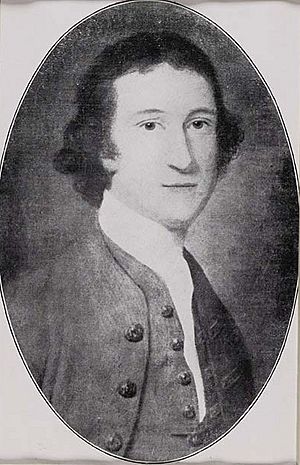 |
|
| Born | 21 February 1729 |
| Died | June 13, 1803 (aged 74) |
| Nationality | Scottish |
| Occupation | Planter |
| Known for | Knight -v- Wedderburn |
Sir John Wedderburn of Ballindean (1729–1803) was a Scottish landowner. He became very rich by growing sugar in the West Indies using enslaved people. His family was once important but had become poor. His father was executed for treason after a rebellion in 1745.
Young John Wedderburn had to leave Scotland. He went to the West Indies, where he became a huge landowner in Jamaica. In 1769, he returned to Scotland with an enslaved man named Joseph Knight. Knight was inspired by a court case in London that said slavery did not exist under English law. Knight sued Wedderburn for his freedom. Wedderburn lost the case, which meant that Scots law also did not support slavery. Sir John Wedderburn later became a wealthy gentleman. He brought back his family's fortune and their old title.
Ballindean is a country estate located between Perth and Dundee.
Contents
Early Life in Scotland
John Wedderburn was born in Scotland on February 21, 1729. His father, also named Sir John Wedderburn, was a gentleman from Perthshire. However, his family had fallen on hard times. They lived on a small farm and struggled to support their nine children.
In 1745, John's father joined the rebellion against the king. He served as a colonel in the Jacobite army. He was captured after the Battle of Culloden. He was taken to London for trial. On November 28, 1746, he was found guilty of treason and executed in a very harsh way.
Young John Wedderburn went to London to try and save his father. But he failed. He had to watch his father's execution. After this, he returned to Scotland. He had no inheritance and no future there. So, he decided to travel to the New World. In Glasgow, he found a ship captain who let him work for his passage to the Caribbean.
Building a Fortune in Jamaica
In early 1747, Wedderburn arrived in the British Colony of Jamaica. This island had been taken from the Spanish in 1655. It was quickly becoming a major place for growing and exporting sugar. Young Wedderburn settled near Montego Bay in western Jamaica. He tried different jobs, even working as a doctor for a few years without training.
He managed to save enough money to become a planter. He bought land, enslaved people, and invested in sugar. This was a very profitable business at the time. Wedderburn's sugar plantations grew. He gained huge amounts of land and wealth. At one point, he owned about 17,000 acres of land. This made him the largest landowner in Jamaica. Other family members also followed him to the colony. The Wedderburns built large estates there.
In 1762, Wedderburn bought a young African boy at an auction. The boy was about 12 or 13 years old. His name was Joseph Knight. Instead of making Knight a field worker, Wedderburn made him a house servant. He taught Knight to read and write. He also had him baptized as a Christian.
Returning to Scotland and Family Life
Seven years later, in 1769, Wedderburn returned to Scotland. He brought Joseph Knight with him. He wanted to restore his family's good name. He also wanted to marry and start a family. In 1769, he bought the Ballindean estate. This estate is near Inchture, a village between Dundee and Perth. The Ballindean House you see today was rebuilt in 1832.
On November 25, 1769, Wedderburn married Margaret Ogilvy. She was from a family that had also faced treason charges. They had four children, but only three lived to be adults:
- Margaret (1772-1807) married Philip Dundas. He was an important official and later a Member of Parliament.
- Jean (1773-1861) married John Hope Oliphant.
- Sir David Wedderburn, 1st Baronet.(1775-1858)
Margaret Ogilvy died shortly after David was born.

Wedderburn's second wife was Alicia Dundas. They had several children:
- Sir John Wedderburn, 2nd Baronet (1789-1862)
- Mara/Maria
- Susan
- Louisa Dorothea, who married General Sir John Hope.
- Anne (1788-1867)
Around 1778, Joseph Knight fell in love with a servant girl named Annie Thompson. Wedderburn allowed them to marry.
The Joseph Knight Case
Around 1778, Joseph Knight learned about a court decision in England. This decision said that slavery did not exist under English law. Knight thought this rule also applied in Scotland. So, he demanded his freedom and even asked for back pay. Wedderburn refused. He felt he had been good to Knight by educating him.
Soon, Annie Thompson became pregnant. Wedderburn fired her. He also refused to let Knight leave. When Wedderburn found Knight packing his bags, he had him arrested. Knight was put in Perth jail. But Knight convinced the local sheriff that he had a right to be free. So, Knight filed a lawsuit against Wedderburn. This case became known as Knight -v- Wedderburn.
First Court Decisions
At first, the Justices of the Peace ruled against Knight. But Knight appealed to the Sheriff Court of Perth. This court ruled in Knight's favor. The Sheriff stated that:
- "the state of slavery is not recognised by the laws of this kingdom, and is inconsistent with the principles thereof: That the regulations in Jamaica, concerning slaves, do not extend to this kingdom"
This meant that slavery was not allowed in Scotland.
Appeal to Scotland's Highest Court
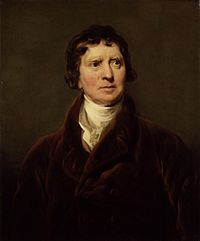
In 1777, Wedderburn appealed to the Court of Session in Edinburgh. This was Scotland's highest civil court. He argued that Knight still owed him service, like an apprentice. The case was very important. Twelve judges heard it, including Lord Kames, a famous legal expert.
Henry Dundas, a powerful lawyer, represented Knight. He was very upset by Knight's situation. He was helped by James Boswell and Samuel Johnson, two well-known writers. They strongly supported Knight's defense. Their main argument was that "no man is by nature the property of another." Since Knight had not given up his freedom, he should be set free.
Wedderburn's lawyers argued that business interests were more important. They said that Scotland's wealth depended on trade, which included slavery.
But Lord Kames said, "we sit here to enforce right not to enforce wrong." The court strongly rejected Wedderburn's appeal. By a vote of 8 to 4, they ruled that:
- "the dominion assumed over this Negro, under the law of Jamaica, being unjust, could not be supported in this country to any extent: That, therefore, the defender had no right to the Negro’s service for any space of time, nor to send him out of the country against his consent: That the Negro was likewise protected under the act 1701, c.6. from being sent out of the country against his consent."
This decision meant that Scots law did not recognize slavery. Enslaved people who escaped or were brought to Scotland could be protected by the courts. They could not be forced to return to slavery in the colonies.
Later Life and Legacy
Wedderburn was not discouraged by his loss in court. He spent the rest of his life supporting the rights of slaveholders. He eventually succeeded in claiming the title 6th Baronet of Blackness. This helped restore his family's good name after his father's execution.
On December 27, 1780, he married Alice Dundas. She was related to Henry Dundas, 1st Viscount Melville, a famous politician. They had three boys and four girls. His son John (1789–1862) later became the second baronet.
Sir John Wedderburn died on June 13, 1803, at the age of 74.
In Fiction
Sir John Wedderburn is a character in the novel Joseph Knight (2003) by James Robertson.
Family Connections
John Wedderburn's first cousin, Catherine Read, was a portrait painter. She took in his sisters after their father was executed.
His brother, James Wedderburn-Colville, had several children. One of them was Robert Wedderburn. He was a preacher and a strong opponent of slavery. In 1824, he published an anti-slavery book called The Horrors of Slavery.
Other children of James included Andrew Colvile, who led the Hudson's Bay Company. Another son, Peter, became a ship captain.
His grandchildren included Jemima Blackburn (1823 – 1909). She was an artist known for her bird illustrations.
See also
- List of slave owners
- Clan Wedderburn


